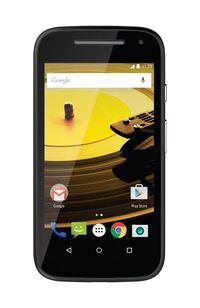Motorola Moto E 2015 (motorola-surnia)
| This page is about the dedicated port of this device. There is also an optional generic port available for this device - see Generic MSM8916 (qcom-msm8916). |
 Motorola Moto E (2nd Gen) | |
| Manufacturer | Motorola |
|---|---|
| Name | Moto E (2nd Gen) |
| Codename | motorola-surnia |
| Released | 2015 |
| Type | handset |
| Hardware | |
| Chipset | Qualcomm Snapdragon 410 (MSM8916) |
| CPU | Quad-core 1.2 GHz Cortex-A53 |
| GPU | Adreno 306 |
| Display | 540x960 IPS LCD |
| Storage | 8 GB Flash |
| Memory | 1 GB |
| Architecture | aarch64 |
| Software | |
Original software The software and version the device was shipped with. |
Android 5.0.2 |
Extended version The most recent supported version from the manufacturer. |
Android |
| postmarketOS | |
| Category | testing |
Mainline Instead of a Linux kernel fork, it is possible to run (Close to) Mainline. |
yes |
pmOS kernel The kernel version that runs on the device's port. |
3.10.49 |
| Optional Generic Port | Generic MSM8916 (qcom-msm8916) |
| Device package |
|
| Kernel package |
|
| Firmware package |
|
Flashing Whether it is possible to flash the device with pmbootstrap flasher. |
Works
|
|---|---|
USB Networking After connecting the device with USB to your PC, you can connect to it via telnet (initramfs) or SSH (booted system). |
Works
|
Internal storage eMMC, SD cards, UFS... |
Works
|
SD card Also includes other external storage cards. |
Works
|
Battery Whether charging and battery level reporting work. |
Partial
|
Screen Whether the display works; ideally with sleep mode and brightness control. |
Partial
|
Touchscreen |
Works
|
| Multimedia | |
3D Acceleration |
Works
|
Audio Audio playback, microphone, headset and buttons. |
Works
|
Camera |
Broken
|
| Connectivity | |
WiFi |
Works
|
Bluetooth |
Works
|
GPS |
Untested
|
| Modem | |
Calls |
Partial
|
SMS |
Partial
|
Mobile data |
Partial
|
| Miscellaneous | |
FDE Full disk encryption and unlocking with unl0kr. |
Untested
|
USB OTG USB On-The-Go or USB-C Role switching. |
Partial
|
| Sensors | |
Accelerometer Handles automatic screen rotation in many interfaces. |
Broken
|
Ambient Light Measures the light level; used for automatic screen dimming in many interfaces. |
Broken
|
Proximity |
Broken
|
Haptics |
Works
|
Power Sensor Sensor to monitor current, voltage and power. Not fuel gauge! |
Broken
|
| This device is based on the Snapdragon 410. See the SoC page for common tips, guides and troubleshooting steps |
Contributors
Users owning this device
- BogdanTheGeek (Notes: Running android for now)
- Chipmunk (Notes: XT1526)
- Dominduchami
- Frbrr02 (Notes: Model: XT1524)
- Icenowy
- Illen (Notes: Dying battery, runs mainline.)
- Palm3xeADM3a
- Pangelo (Notes: cracked screen but works fine)
- Proycon
- Rsquared (Notes: msm8916 - working inx panel!)
- Techwizz (Notes: Mainline testing)
- Thenightterrorx (Notes: boots fine off sd card)
- UnDevDeCatOS (Notes: is currently being lend to someone else)
- Unrznbl (Notes: 2023-12-01 mainline, gestures fixed in shelli-ui last year)
- Wiktorek140
- Xonney1 (Notes: Cracked screen, functional)
- Yeswap (Notes: Edge Phosh)
Unlocking the bootloader
Please visit the Motorola website for instructions. You will need a email address for only receiving email (disposable email is enough) and working fastboot (driver installation needed for Windows and macOS, works out of the box on Linux).
How to enter flash mode
Hold down + while booting to enter Flash Mode.
Installation
First, flash lk2nd-msm8916.img to the boot partition.
Boot that, press volume down during that booting to get to the lk2nd boot menu.
See Usage for lk2nd.
After that, use the normal Installation_guide
Installation to directly to device and sdcard have both been tested to work.
Note: A recent (edge, alpine-release 3.19_alpha20230901, kernel 6.5.2) attempt to install using a recovery zip image on an SD card fails (pmaports#1877, not specific to surnia, but rather to MSM8916). The end of pmos.log file shows:
+ chroot /tmp/postmarketos/chroot /bin/busybox --install /bin chroot: can't execute '/bin/busybox': No such file or directory
Display
The display panel works fine, but backlight control doesn't due to missing driver for BD65B60 IC.
Battery
Battery fuel gauge is supported, but fan54046 charging chip isn't. It does still charge but it doesn't indicate that it is charging.
USB OTG
Device cannot supply its own power, so you must use a powered otg adapter for usb otg to work.
Firmware {Wifi/Modem}
The firmware is now properly packaged since pmaports!1947
Modem
Modem may not work on some variants due to lack of support for compressed firmware images in rmtfs. This will also break sound on affected devices. To get sound working, you can choose the no-modem remote processor provider in pmbootstrap init. Alternatively you can apply this workaround to get modem working.
Hardware / sensors detail
For reference, sensor information from sensorsandbox (f-droid) on xt1526; note that in addition to hardware-based sensors, it presumably includes software-based / derived sensors:
sensor details (sensorssandbox)
| name | vendor | version | type |
|---|---|---|---|
| 3-axis accelerometer | Kionix | 1 | 1 |
| Ambient light sensor | TAOS | 1 | 5 |
| Proximity sensor | TAOS | 1 | 8 |
| Display rotation sensor | Motorola | 1 | 65536 |
| Flat up | |||
| Flat down | |||
| Stowed | |||
| Camera activation sensor |
Sensors appear to be handled by Motorola Sensorhub
See also
- pmaports#1425 Display issue
- Sensorhub RE git repository
- pmaports!3329 Switch from downstream to mainline. 2022-09-14.
- pmaports#1877 Recovery zip can be generated, but installation will fail